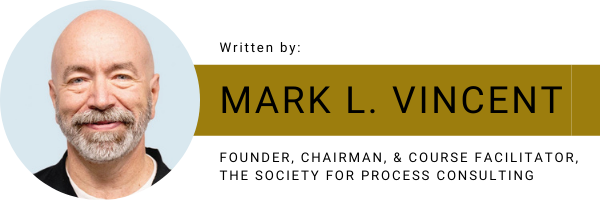 Mark L. Vincent is a founder, chairman, and course facilitator here at the Society for Process Consulting. He recently authored the book Listening Helping Learning: Core Competencies of Process Consulting, which contains a wide variety of case studies from some of our own members! Today's blog is the first of three in which Mark will hone in on the categories of the process consulting competencies: listening, helping, and learning.
Mark L. Vincent is a founder, chairman, and course facilitator here at the Society for Process Consulting. He recently authored the book Listening Helping Learning: Core Competencies of Process Consulting, which contains a wide variety of case studies from some of our own members! Today's blog is the first of three in which Mark will hone in on the categories of the process consulting competencies: listening, helping, and learning.
Dacia Coffey prefaces her recent book Corporate Caffeine with these words:
Communication deterioration is a human condition (p. xiii)
The remedy she suggests?
Putting servant leadership at the heart of your communication (p. xix).
Being a servant leader who communicates well begins with the listening side of communication. Or, as described in the book Nonviolent Communication, by receiving empathically. This is not listening for a hook by which to begin speaking. Neither is it passive, waiting until someone finishes speaking. Real and active listening grows from bringing love to a conversation, an unconditional positive regard for the people across from you.
This work to serve communication by making your listening the center, rather than your message, puts you in partnership with others rather than competing with them for airtime. Especially in an organization, the conversation, this working session to understand, develop and share insight, requires safety -- enough safety to get past amygdala hijackings to consider the benefits of a change a working group will implement together. This safety is possible because someone is serving the conversation through listening. Once someone starts listening this way, it becomes far more feasible for others to join in that listening.
As listening becomes something done jointly, the language of our communication shifts from statements to additional questions--from Let me tell you something, or I just wanna say to, Do I have this right? and Have I missed anything? and Is there anything else?
With this shift, we begin actively and comprehensively listening together. Now we can become sensitive to conceptual insight and the context in which our problem or opportunity is showing up. We can begin listening for the architectural elements of a process we will engage in and then move into that process better able to recognize adaptive moves we will need to make. We can do all this because we lean in to listen rather than lasso the conversation away from someone else.
Servant leadership brought to communication requires such intentionality that a person must do their personal work--listening to themselves--outside of conversations not to be personally distracted or derailed within them. Being honest about this, I admit that even in writing this blog post, I had to stop and get in touch with the irritations of the day -- an e-mail response to me I did not like, ironically, because I did not feel listened to, a personal concern where I might not like the answer when I ask an essential question of a friend, a deadline I need to meet yet today, as well as the next item on my agenda once I complete this. All these crowd in and start me rushing, writing sentences distractedly, being elsewhere than this moment I'm in. I breathe deeply and call my intention and attention back to capturing thoughts begins again.
Listening in this way, I'm not just listening to a person or a thing. I'm not just listening to my being or thoughts on a subject. And, I'm not just listening to the audience I hope will read this, trying to adjust my words to gain their interest. I am being present and growing my awareness of a moment in which we all might share. I'm not just pointing to or describing the subject of listening with words. I am in its presence, taking it in--hopefully in such a way that you and others join me--and our understanding grows together.
We can't do this type of listening when we are talking.
We can't do this type of listening when we look like we are listening but only are waiting our turn to speak.
We can't do this type of listening if we are thinking about listening.
We can begin listening in this way in our intention to serve good communication by bringing our whole and highest self to the problems and opportunities we join with others.
Listening--the kind of listening that ripples out to others, until a whole team is engaged in thoughtful collaboration--is an art form. We need more of these artists at the helm.
